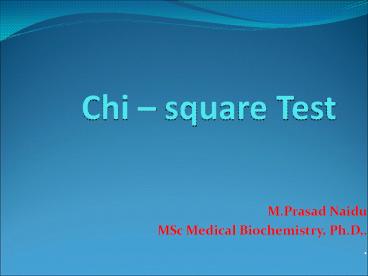Chi – square Test - PowerPoint PPT Presentation
Title:
Chi – square Test
Description:
Biostatics – PowerPoint PPT presentation
Number of Views:739
Title: Chi – square Test
1
Chi square Test
- M.Prasad Naidu
- MSc Medical Biochemistry, Ph.D,.
- .
2
- Introduction
- Chi-square test offers an alternate method of
testing the significance of difference between
two proportions. - Chi-square test involves the calculation of
chi-square. - Chi-square is derived from the greek letter chi
(X). - Chi is pronounced as Kye.
- Chi-square was developed by Karl pearson.
3
- Chi-square test is a non-parametric test.
- It follows a specific distribution known as
Chi-square distribution. - Calculation of Chi-square value
- The three essential requirements for Chi-square
test are - A random sample
- Qualitative data
- Lowest expected frequency not less than 5
4
- The calculation of Chi-square value is as
follows - - Make the contingency tables
- - Note the frequencies observed (O) in each
class of one event, row-wise and the number in
each group of the other event, column-wise. - - Determine the expected number (E) in each
group of the sample or the cell of table on the
assumption of null hypothesis.
5
- - The hypothesis that there was no difference
between the effect of the two frequencies, and
then proceed to test the hypothesis in
quantitative terms is called the Null hypothesis. - - Find the difference between the observed and
the expected frequencies in each cell (O E). - - Calculate the Chi-square values by the
formula - - Sum up the Chi-square values of all the
cells to get the total Chi-square value.
6
7
(No Transcript)
8
(No Transcript)
9
- - Calculate the degrees of freedom which are
related to the number of categories in both the
events. - - The formula adopted in case of contingency
table is - Degrees of freedom (d.f.) (c 1 ) (r
1) - Where c is the number of columns and r is
the - number of rows
10
- Applications of Chi-square
- Chi-square test is most commonly used when data
are in frequencies such as the number of
responses in two or more categories. - Chi-square test is very useful in research.
- The important applications of Chi-square in
medical statistics are - - Test of proportion
- - Test of association
- - Test of goodness of fit
11
- - Test of proportion
- It is an alternate test to find the significance
of difference in two or more than two
proportions. - Chi-square test is applied to find significance
in the same type of data with two more
advantages, - - to compare the values of two binomial
samples even if they are small. - - to compare the frequencies of two
multinomial samples.
12
- - Test of association
- Test of association is the most important
application of Chi-square test in statistical
methods. - Test of association between two events in
binomial or multinomial samples is measured. - Chi-square test measures the probability of
association between two discrete attributes.
13
- - Test of Goodness of fit
- Chi-square test is also applied as a test of
goodness of fit. - Chi-square test is used to determine if actual
numbers are similar to the expected or
theoretical numbers goodness of fit to a
theory.
14
- Restrictions (limitations) in application of
Chi-square test - The Chi-square test is applied in a four fold
table will not give a reliable result with one
degree of freedom if the expected value in any
cell is less than 5. - The Chi-square test does not measure the strength
of association. - The statistical finding of relationship, does not
indicate the cause and effect.
15
Thank You

